
Garmin obliged with its usual explicit directions.
We were a bit slow to comprehend the silliness of following a very narrow dirt track ... how could Garmin be wrong?
Shortly after this photo we began the tedious task of reversing along the single lane track with mud walls a bit close at times.
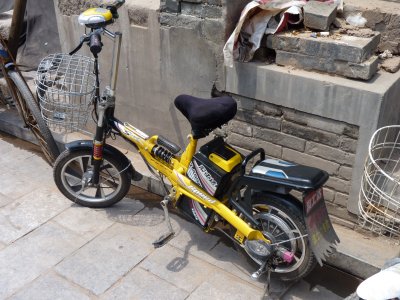
Any vehicle wider than a golf cart is excluded during the day.
There are lots of these electric scooters.
Very sophisticated.
There's a pivot just in front of the pedals and a spring for suspension. The front forks also have suspension.
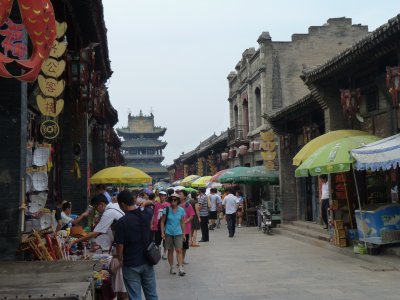
The layout is a North and South gate, with two gates in each of East and West walls.
Head, tail and legs of the tortoise.
Two wells outside the South gate are the eyes.
The city is substantially intact, having escaped the restoration efforts of Dali and Li Jiang. Though it is similarly UNESCO Heritage Site listed.
For what its worth we have an impression of traveling through the industrial North of China. Lots of the characteristics of heavily industrialised areas anywhere on the globe. Perhaps grey rather than opulent.
The paving stones are new (originally dirt). No open flowing water, just enclosed drains.
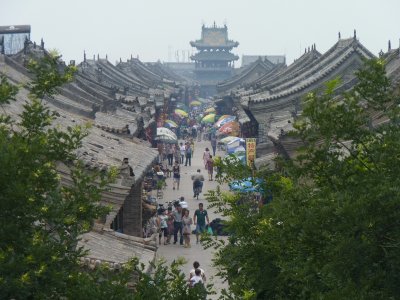
The city is square, all streets are perpendicular to each other.
Our tickets are for entry to any of more than 20 museum items over 3 days.
We started with the wall.
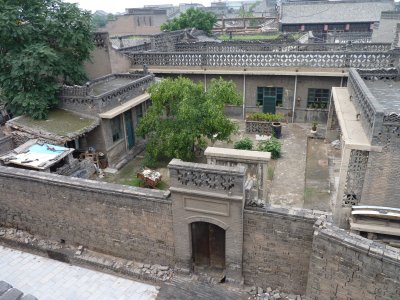
About 400 of the original remain.
Most seem to have a screen inside the front gate.
This is an image of the residences of families operating successful businesses.
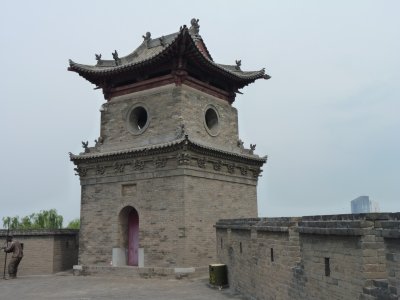
The imperial city is laid out in accordance with Han standards.
The city has been here a long time, the wall is about 600 years old.
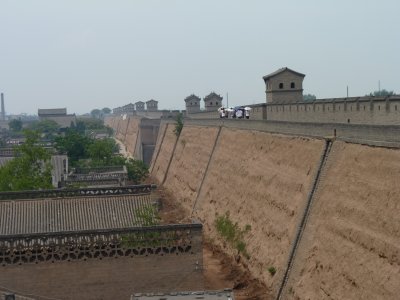
The numbers 4, 8, 72 are special numbers in Confucian philosophy.
But we don't know how special! Or why.
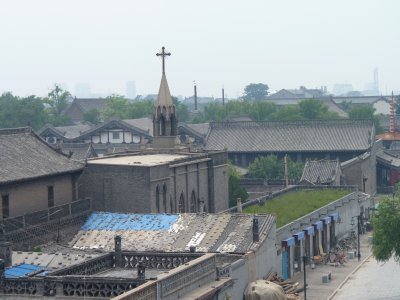
No mention in any of the brochures. Apparently a catholic church.
Looking ahead, the following day we drove past what looked like a cathedral and an orhodox Christian church but weren't quick enough to take photos.

And Ali.
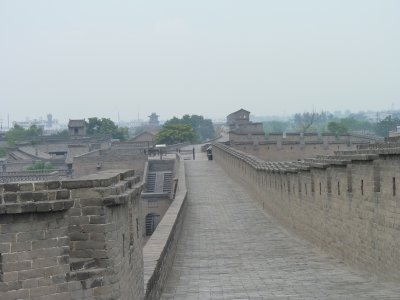
On a grey day, for which we were grateful as the temperatures have been high at times, the brickwork was far from attractive to us.
Reminiscent (to me) of some run-down North of England mill town. The haze reinforced the memories of industrialisation.
For brick afficionados these black bricks are larger than any we've seen elsewhere and larger than a standard UK/Australian house brick. Possibly difficult to lay with one hand.
Having had enough of wall walking (about 1km) we headed eagerly for the steps.
Locked.
We ended up walking about 4 km, halfway around the wall. Not a bad idea really, a bit like walking round the outside of a goldfish bowl. Pretending we knew all about the goldfish.
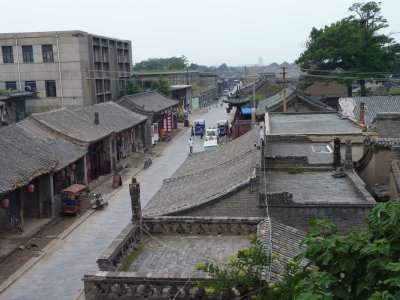
The one on the left was a bit derelict. We saw what we thought were an old, disused, power station and a disused prison (with high tension electric wires along the top of the wall).

These houses were a bit smaller than most.
This is a slice of life from days gone by.
We've obviously been spoiled. Not a place we would choose to live.
And therein lies the quandary. We like to look at life as it was, and Pingyao is truly fascinating, but we wouldn't like to live it.
We could live in Dali or Li Jiang, but both are extensively rebuilt, tourist havens, and no way as "authentic" as Pingyao.
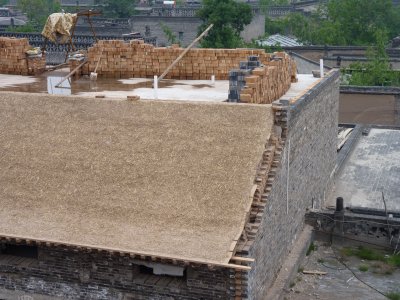
The end wall is double brick. The roof so far is boards with earth / straw on top.
In subsequent complete (but old) roofs we saw it looked like the tiles were laid on top of the earth with more earth to fill the curves.
We couldn't confirm (there isn't an instruction manual for how to build a Han house in Pingyao).
We think its probably insulation - it gets a bit cold in Winter.
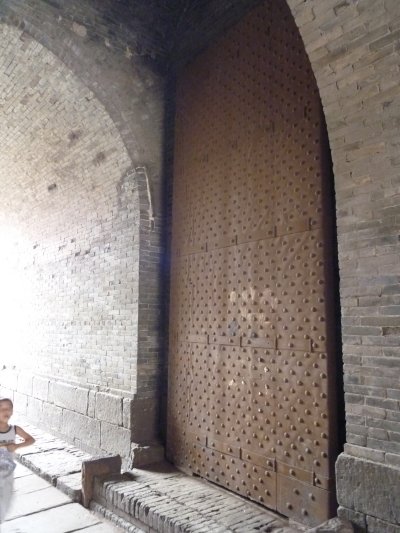
This is one of the doors.
At Mian Shan we'd seen a small drawbridge which started a discussion about "where's the portcullis and the holes for boiling oil?".
At Pingyao it looked like the gate had two sets of doors with a largish open space in between.
Lots of opportunity for archery practice.
The watchtowers are about twice the distance an arrow can be fired accurately apart.
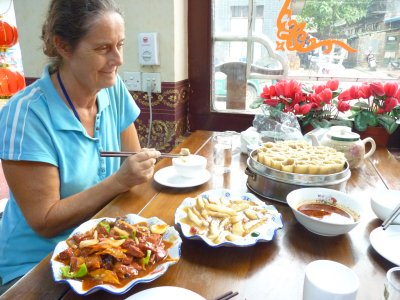
Beef (marinated lots), mountain noodles. and Chinese yams in honey.
Beef is a speciality in Pingyao, but we haven't seen any cattle in fields ...

Pingyao is situated between Beijing and Xi'an.
An old trade route.
The Manager of a local dye shop realised that instead of trying to transport silver, and have it stolen, a bit of paper could be transported instead.
This building is the site of the first Draft Bank in China. The Rishengchang Bank. Established about 1823.
Bank drafts which can be honoured in a different city than the one in which they were issued.
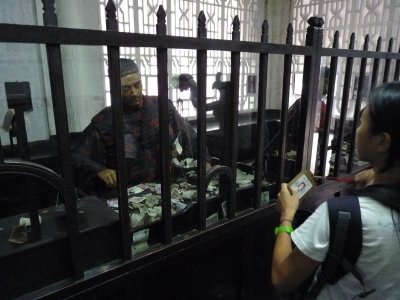
Rishengchang Bank had about 35 branches.
There were about 20 other banks established (must have been a good idea).
I wonder if they honoured each others' drafts.
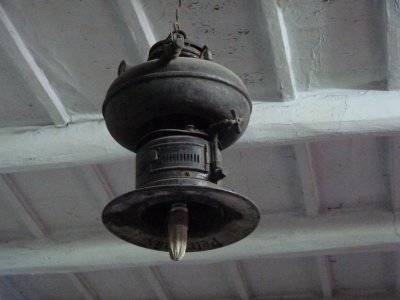
Or is it?
Perhaps much better than having the tank cast a shadow ...
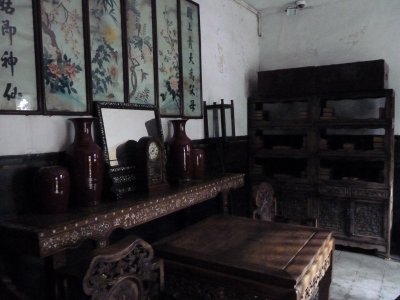
The Bank had to establish its own messenger service though later it used China Post.
We first met mention of "imperial exams" at the Confucian Temple in Jian Shu (way back on June 24th).
The secretary of messages had to have done well in the imperial exams.
The organisation structure of the bank was such as to separate ownership and operation. Also to ensure honesty among the clerks (through a mixture of reward and punishment).
Honesty and trust were perceived as a key to banking success.
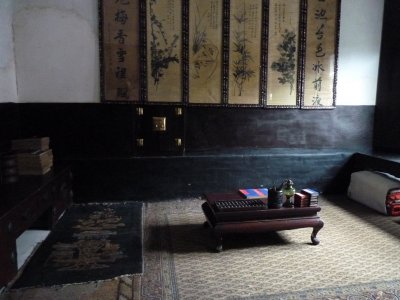
Chief Accountant and 3 or more clerks.
I once thought of learning how to use an abacus (there's one on the table and lots for sale on the streets) but the opportunity has always eluded me.
The banks reached their hayday and went into decline in the 19th century as Western business practices were imported and became more prevalent.
I could find no information on the differences.
There were no ATMs in Pingyao.
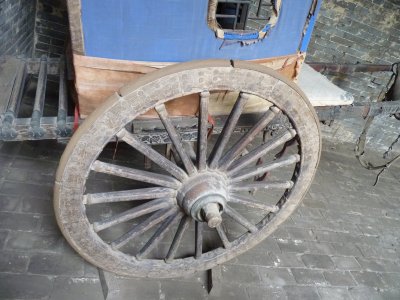
Though why it doesn't simply fall to pieces at the first bump in the road eludes me as much as abacus operation.
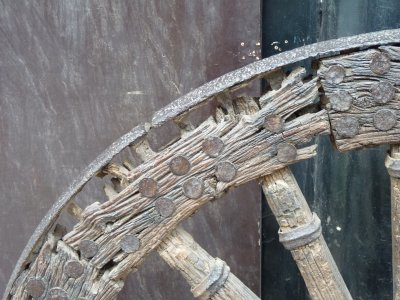
This (and the ones on all the old wheels we saw) has a steel tyre which has breaks in it. Made of short lengths.
Presumably the pins tightened the spokes and weight on the axle somehow held it together somehow. It obviously didn't fall to pieces easily.
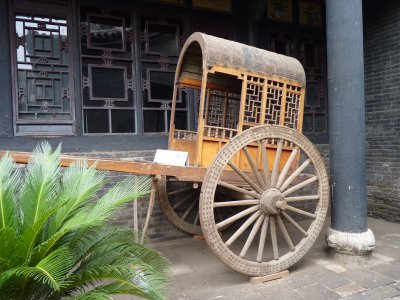
I also couldn't help noticing the lack of suspension.
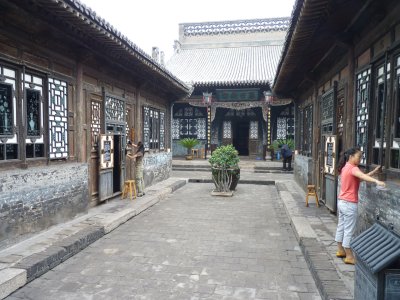
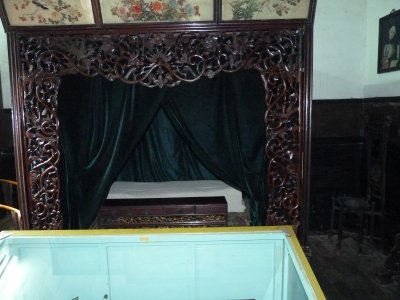
Maybe it was relatively soft after riding in one of the suspension free people carriers.

We thought the brown paper bags with sand in them were weights to help weigh the money.
Not quite. They were for fire fighting.
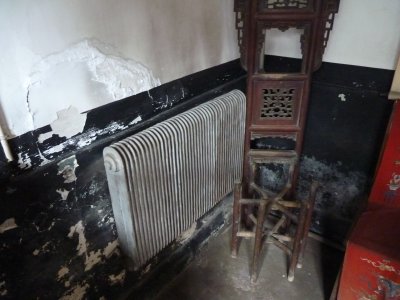
Central heating. Hot water circulated.
We also saw it in some of the restaurants.
This radiator is readily recognisable to our eyes. Some of the other designs were less so. Just the water pipes in and out, and the valves.
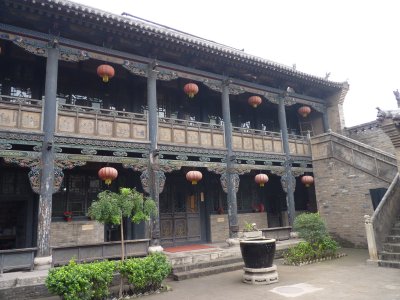
A hall to entertain wealthy customers.
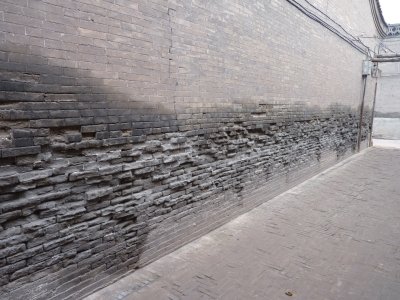
Evidence of some wear and tear of the bricks.
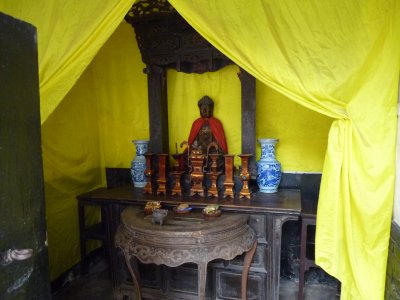
An armed escort agency silly!
This is the Buddhist Hall which all escort agencies have.
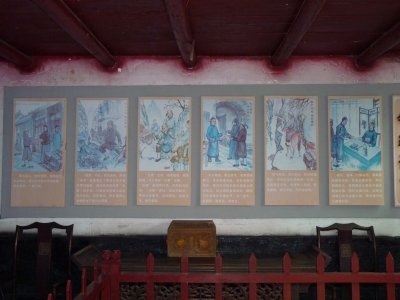
It began with the bit of paper to authorise the task, picking up the high value goods, challenging bandits in places where ambush could occur, negotiation with bandits, conflict if it couldn't be avoided, delivery of the goods, and delivery of the bit of paper.
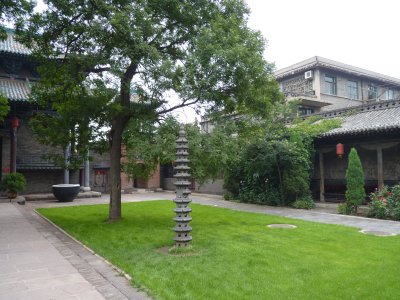
We've seen quite a few.
It seems to be associated with local government in some way..

The bell is rung in the morning. Mainly to tell the time methinks.
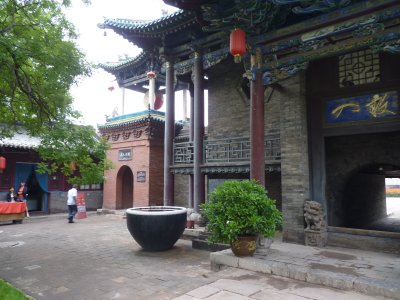
The drum is beaten in the evening.
Drum and Bell Towers are not unique to Xi'an.
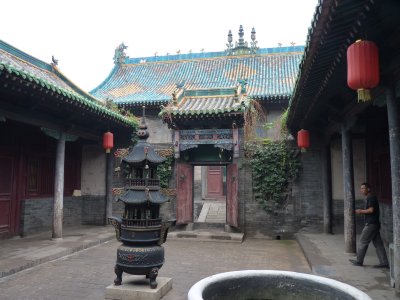
He worked in the front, slept in the rear.
The god (governor?) and his wife slept in the central room. His concubine in the Eastern room.

Ornate roofs of the temple complex.
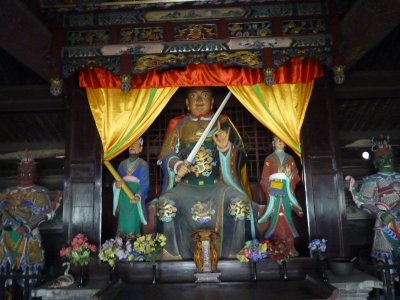
Not sure of this part of the Town God Temple. There were some rather grotesque image of 6 Cao Hell nearby. The stuff of nightmares.
Associated with retribution theory of Daoism plus cause and effect theory of Buddhism.
I promise to be good!
There were also Land, Wealth, Kitchen, and other gods.
All with evidence of active worship.
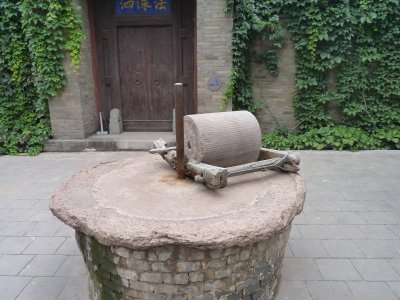
In the Confucian Temple.
Remember that millstone in Zhang Bi.
Well here's another, with a wooden frame attached to the central post.
There were spindles at both ends of the millstone for rotation, no aligned.
A bit easier to see how it may have worked.
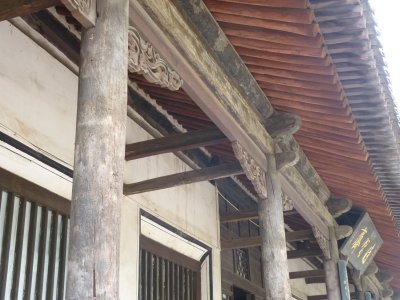
The horizontal pieces extended into the building and were attached to more upright pillars.
In the inside of the Dacheng Hall (where statue of Confucius is installed) I was reminded that photos were not allowed.
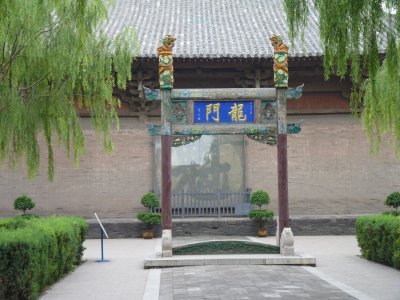
Well this is the Dragon Gate and the Fish jumped over the cross piece at the bottom.
If I heard it correctly the leaping fish is symbolic of people who have achieved success.
We noticed a few people jumping over the bar.

These are some of the completed examination papers. There is one from the Ming Dynasty, the highest score in its year, but no photographs.
By coincidence we've been listening to "the Hitchikers Guide to the Galaxy" in the evenings (doesn't everyone take a copy of the CDs to China?).
We'd tried a few times to get a translation of questions and answers but failed totally.
Nearly fell over laughing as we were leaving and heard an American voice, with more than a tinge of frustration, asking "but what was the question?"
On a serious note, good results in the imperial exams seem to be a prerequisite for success in many spheres. Not unlike any education system perhaps.
I wonder if anyone kept any of my old exam papers for future display in a museum? Can't imagine why not!
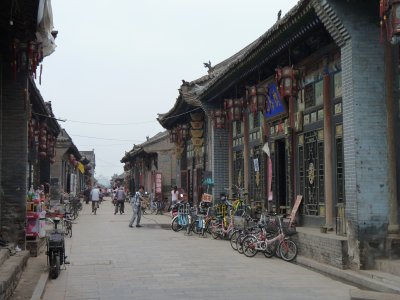
China is a fascinating place, but oh so difficult to make sense of.
We thought we'd best retreat to the Tardis to let our brains recover and process all we'd seen.
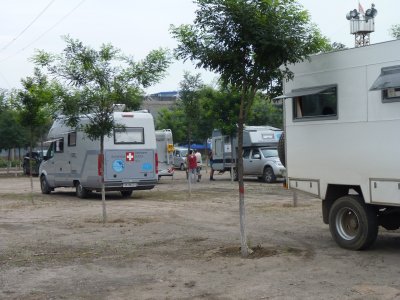
20 motorhomes on a commercial German led 6 month trip from Moscow, through Russia and Mongolia to Beijing, to Xi'an then to Turkey along the Silk Road.
Mostly German but also Swiss and a Dutch couple. Mostly retired.
Some of them were experienced travelers having taken their motorhomes to South America and other places. Mostly conventional 2wd motorhomes with a couple of 4wd.
Some of them were stuck and needed towing in sand in the Gobi. There were also trucks stuck. They "discovered" how to let air out of tyres. Time will tell for us..... hopefully our limited Aus experience will be of use.
In our planning we hadn't found a map of Mongolia despite lots of trying. A source of increasing concern with only a couple of weeks before we have to find our way.
Had a fascinating couple of hours chatting with Arthur, the Tour Director, after he'd settled the tour down for the night. He gave us his German published map of Mongolia plus street map of Ulan Baator. Also a useful English contact in Ulan Baator and quite a few hints for Mongolia and Russia.
Many thanks indeed Arthur. One of those special times we talked about and will remember. "Magic".
Nice to have visitors and a welcome break for us.